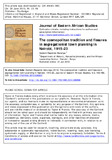| dc.contributor.author | Murunga, Godwin R | |
| dc.date.accessioned | 2015-07-01T06:25:40Z | |
| dc.date.available | 2015-07-01T06:25:40Z | |
| dc.date.issued | 2012 | |
| dc.identifier.citation | Journal of Eastern African Studies Volume 6, Issue 3, 2012 | en_US |
| dc.identifier.uri | http://www.tandfonline.com/doi/abs/10.1080/17531055.2012.696896 | |
| dc.identifier.uri | http://hdl.handle.net/11295/85808 | |
| dc.description.abstract | This article argues that the attempts to institute segregation in Nairobi faltered because the process of urban land allocation, use and exchange and the legislation supporting this process did not support segregation. It uses the example of the removal of the Somali settlement in Ngara and the debates around the removal of the Indian Bazaar to demonstrate this failure. Through a study of the emergence of Eastleigh, the paper demonstrates that business-inclined settlers demanded a system of town planning that was class-based rather than race-based. In 1923, the colonial state conceded that segregation between European and Asiatics is not absolutely essential for the preservation of the health of the community. Overall, the article exposes a particular futility in the history of Nairobi – the attempt to achieve segregation using a planning vision that was suffused with cosmopolitan realities. | en_US |
| dc.language.iso | en | en_US |
| dc.subject | Segregation | en_US |
| dc.subject | Town planning | en_US |
| dc.subject | Indian Bazaar | en_US |
| dc.subject | Nairobi | en_US |
| dc.subject | Cosmopolitanism | en_US |
| dc.subject | Eastleigh | en_US |
| dc.title | The cosmopolitan tradition and fissures in segregationist town planning in Nairobi, 1915–23 | en_US |
| dc.type | Article | en_US |
| dc.type.material | en_US | en_US |

